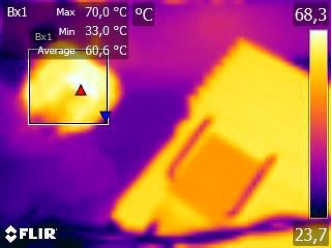👋 Hello! Dr. Molina here! 👨🔧
🤗 Thank you for reading and welcome to the show my Newsletter.
I’m Founder and CEO at Frenetic, where we train and create Great Magnetic Engineers 🚀.
👉 A lot of semiconductor companies are offering solutions for the 65W USB adaptors. Since TI, Silanna, Infineon, and ST…and probably many other companies.
Today I will share a design of a Flyback magnetic, comparing predictions with experimental results.
If you want to receive this Newsletter in your inbox automatically, subscribe!!
The Weather forecast
Yesterday, I had my traditional weekend tennis match. I woke up at 7 am, and I saw a notification on my iPhone from my opponent. He wrote to me:
-Hi Chema! The weather forecast of the iPhone says 90% of the probability of rain
-Well, then, we should cancel.- I answered.
We canceled the match, but the rain never appeared.
Does this mean the weather prediction is failing? I don’t think so.
After hundreds of years of predicting the weather, satellites, millions of data from the past, and Artificial Intelligence models, many predictions fail.
In the field of magnetic predictions, sometimes I see some parallelism.
This week, a company of experienced engineers wanted to test Frenetic. We designed an inductor, built a sample, and ship to them. He tested the sample and showed us the results on a specific point, where Frenetic predicted 40 ºC less of temperature. The frenetic model failed at that point.
They compared that specific point, and of course, they were disappointed. The difference between the tool and the experiment was too big. (Like me, I was disappointed with the weather prediction…😡)
When the weather forecast of the iPhone was wrong, I didn’t think always is going to be incorrect. I just said today’s predictions failed. It has probably been unable in hundreds of other points on the planet, but I’m sure he has been successful in most cases.
The problem with predicting complex issues is the number of factors that couldn’t be considered if you want to have real-time predictions.
Then, being honest. Never, ever, Frenetic will guarantee you 100% of accuracy in temperature predictions. However, you will always be able to iterate by software, having some experimental results as a reference, because the relative losses between solutions are great.
For those that are designing a 65 W Flyback with Frenetic, this is a good reference point to start with. We are working on many example cases to be included in our Magnetic Notes, where we will basically give reference points with experimental verification.
Specifications
The circuit we are talking about is the Flyback with Active Clamp. A very common approach for avoiding ringing due to the resonance between the Llk, the parasitic capacitance of the semiconductor, and the secondary impedance is referred to as primary winding.
The transformer specifications for the circuit (Figure 1) are described in Table 1.
I haven’t included any additional winding in this case because I was testing the design accuracy and the temperature. However, including the classic auxiliary windings wouldn’t be a problem, and I wouldn’t expect significant changes.
Core
For the core, I chose a RM8/I with 3C97 because were fitting in size.
I chose 24 turns and a GAP of 0,26 mm to achieve the inductance needed. For this core size, it’s an appropriate value.
I doubt the core losses because the Magnetic field is Bac = 126 mT, and losses in the core are 1W. If the system doesn’t work, I will increase the number of turns to reduce the losses in the core.
Winding
There are only two windings. I like to work with Litz wires at this frequency range. Allows me to reduce the Rac losses, keeping an easy construction (If I chose round, I would need a lot of parallels, and I would need to solder all of them later, Litz wire is much easier)
Since reinforced isolation is needed, I use triple isolated wire in the secondary to avoid a custom bobbin and comply with creepage.
The selected diameter for the primary winding is 0,05 mm and 0,1 mm in the secondary to keep current density under control.
Regarding the position of the windings, I applied simple interleaving (PSP) to reduce the Leakage inductance without too much complexity.
Summary of the predictions
Once I finished the basic design with the basic waveforms, I checked the prediction of the Llk, Rdc, Rac, Core losses, and Winding losses (In the Screen Shot below, you can see all the values). The Leakage inductance prediction is 2,7 uH.
I built the sample, and I did some measurements of the electrical parameters.
The following Table 2 shows the comparison between the measurements and the predictions. You can see there is one lousy prediction (very bad), which is the interwinding capacitance. The rest of the parameters are significant. You can test by yourself if you want to. The DC resistance in primary difference is due to the different longitude of the wires.
Operating Point 1
Now, I enter in the serious part. I put the component in the circuit, and I applied power. The first operating point is described in the following table:
The waveforms measured in the oscilloscope are shown in this picture. I took the CSV file to be uploaded to Frenetic, and as you can see, in the screenshot below, I used the waveforms for estimating the losses under these points.
As you can see, when I include the waveforms in the simulator, the temperature prediction is 43 ºC and Pt=0,77 W.
Now, this is the real picture of the thermal camera. The hot spot is 57,9 ºC; it’s 15ºC higher than the prediction after 1 hour of work. At this power level, I would say the prediction is not good but is not the critical point. The problem here is the losses in the core. This point is working at 150 kHz, and probably, we are underestimating the losses in the core at that frequency.
Operating Point 2
This is the critical point. Working at 240 kHz, the system will have higher losses and the system can collapse. I followed the same procedure as before, I uploaded the CSV waveforms to the platform and moved forward.
In this case, the models predict 66ºC and 1,33W of losses.
We compare the temperature prediction and the thermal camera as we did before.
In this case, the Temperature prediction is 66ºC, and the camera shows 68,3ºC, YESSS!!! I repeated the test several times; the result was the same. The model prediction is amazing!!
Conclusions
Predicting temperature in Magnetics is a very complex problem, where you accumulate all the errors during the process of losses calculation because the temperature prediction at Frenetic comes from losses estimation and the heat dissipation conditions depend on the assembly process of the component. In this case, the design has high accuracy, because the models have been trained with a lot of Flybacks and even like this, in the first point we have 15ºC of difference and I’m still happy.
Regarding the experience of designing with Frenetic, I invite you to test it, not trying to beat the machine, because Frenetic is not fighting against you. Test Frenetic as an engineer looking for a partner in the process of building great power supplies.
There are more than 100 amazing companies in the world with hundreds of engineers learning Magnetics with Frenetic. The main mission of Frenetic is to extract all the knowledge of magnetic design and share it with our users.
That’s all for today. If you have found this article interesting, please, share it with your friends. Thank you in advance!
Sincerely,
Chema 👋




















Amazing great newsletter !! Thank you Chema for showing and sharing such experimental results with the community!!!. It's very self explanatory post on the capabilities of Frenetic simulator, and how the tool will get continuously improving when more experimental data is feeded into AI engine